| Software | | Name | Version | Classification |
|---|
| SHARP | | phasing| CNS | 1 | refinement| MOSFLM | | data reduction CCP4 CCP4 | (SCALA)| data scaling | | | | |
|
|---|
| Refinement | Method to determine structure : :  MAD / Resolution: 1.9→14.97 Å / Rfactor Rfree error: 0.005 / Occupancy max: 1 / Occupancy min: 1 / Isotropic thermal model: Isotropic / Cross valid method: THROUGHOUT / σ(F): 2 / σ(I): 4 / Stereochemistry target values: Engh & Huber MAD / Resolution: 1.9→14.97 Å / Rfactor Rfree error: 0.005 / Occupancy max: 1 / Occupancy min: 1 / Isotropic thermal model: Isotropic / Cross valid method: THROUGHOUT / σ(F): 2 / σ(I): 4 / Stereochemistry target values: Engh & Huber
| Rfactor | Num. reflection | % reflection | Selection details |
|---|
Rfree | 0.222 | 1987 | 9.9 % | RANDOM |
|---|
Rwork | 0.188 | - | - | - |
|---|
all | 0.19 | 20453 | - | - |
|---|
| obs | 0.19 | 20149 | 98.5 % | - |
|---|
|
|---|
| Solvent computation | Solvent model: CNS bulk solvent model used / Bsol: 42.347 Å2 / ksol: 0.391785 e/Å3 |
|---|
| Displacement parameters | Biso max: 56.2 Å2 / Biso mean: 14.51 Å2 / Biso min: 1.48 Å2
| Baniso -1 | Baniso -2 | Baniso -3 |
|---|
| 1- | -0.19 Å2 | 0 Å2 | 0.41 Å2 |
|---|
| 2- | - | 0.52 Å2 | 0 Å2 |
|---|
| 3- | - | - | -0.32 Å2 |
|---|
|
|---|
| Refine analyze | | Free | Obs |
|---|
| Luzzati coordinate error | 0.23 Å | 0.18 Å |
|---|
| Luzzati d res low | - | 5 Å |
|---|
| Luzzati sigma a | 0.15 Å | 0.08 Å |
|---|
| Luzzati d res high | - | 1.9 |
|---|
|
|---|
| Refinement step | Cycle: LAST / Resolution: 1.9→14.97 Å
| Protein | Nucleic acid | Ligand | Solvent | Total |
|---|
| Num. atoms | 2256 | 0 | 25 | 269 | 2550 |
|---|
|
|---|
| Refine LS restraints | | Refine-ID | Type | Dev ideal |
|---|
| X-RAY DIFFRACTION | x_bond_d| 0.005 | | X-RAY DIFFRACTION | x_angle_deg| 1.2 | | X-RAY DIFFRACTION | x_torsion_deg| 22.4 | | X-RAY DIFFRACTION | x_torsion_impr_deg| 0.9 | | | | |
|
|---|
| LS refinement shell | Refine-ID: X-RAY DIFFRACTION | Resolution (Å) | Rfactor Rfree | Num. reflection Rfree | % reflection Rfree (%) | Rfactor Rwork | Num. reflection Rwork | Rfactor Rfree error | Num. reflection all | Num. reflection obs | % reflection obs (%) |
|---|
| 1.9-1.99 | 0.219 | 239 | 9.4 | 0.221 | 2227 | 0.014 | 2543 | 2466 | 97 | | 1.99-2.09 | 0.183 | 238 | 9.4 | 0.184 | 2247 | 0.012 | 2542 | 2485 | 97.8 | | 2.09-2.22 | 0.183 | 266 | 10.4 | 0.183 | 2232 | 0.011 | 2554 | 2498 | 97.8 | | 2.22-2.39 | 0.18 | 259 | 10.1 | 0.179 | 2265 | 0.011 | 2560 | 2524 | 98.6 | | 2.39-2.63 | 0.188 | 235 | 9.2 | 0.188 | 2272 | 0.012 | 2541 | 2507 | 98.6 | | 2.63-3.01 | 0.204 | 244 | 9.5 | 0.204 | 2292 | 0.013 | 2571 | 2536 | 98.6 | | 3.01-3.78 | 0.186 | 237 | 9.3 | 0.185 | 2305 | 0.012 | 2557 | 2542 | 99.4 | | 3.78-14.97 | 0.177 | 269 | 10.3 | 0.178 | 2322 | 0.011 | 2605 | 2591 | 99.4 |
|
|---|
| Xplor file | | Refine-ID | Serial no | Param file | Topol file |
|---|
| X-RAY DIFFRACTION | 1 | protein_rep.paramprotein.top| X-RAY DIFFRACTION | 2 | ion.param | | X-RAY DIFFRACTION | 3 | water_rep.param | | | | |
|
|---|
| Refinement | *PLUS Highest resolution: 1.9 Å / Lowest resolution: 15 Å / σ(F): 2 / % reflection Rfree: 9.9 % / Rfactor obs: 0.188 |
|---|
| Solvent computation | *PLUS |
|---|
| Displacement parameters | *PLUS Biso mean: 14.5 Å2 |
|---|
| LS refinement shell | *PLUS Rfactor Rfree: 0.219 / % reflection Rfree: 9.4 % / Rfactor Rwork: 0.221 |
|---|
 Open data
Open data Basic information
Basic information Components
Components Keywords
Keywords SIGNALING PROTEIN /
SIGNALING PROTEIN /  Response regulator / Rcp1 /
Response regulator / Rcp1 /  Phytochrome
Phytochrome Function and homology information
Function and homology information
 X-RAY DIFFRACTION /
X-RAY DIFFRACTION /  SYNCHROTRON /
SYNCHROTRON /  MAD / Resolution: 1.9 Å
MAD / Resolution: 1.9 Å  Authors
Authors Citation
Citation Journal: Protein Sci. / Year: 2002
Journal: Protein Sci. / Year: 2002 Structure visualization
Structure visualization Molmil
Molmil Jmol/JSmol
Jmol/JSmol Downloads & links
Downloads & links Download
Download 1i3c.cif.gz
1i3c.cif.gz PDBx/mmCIF format
PDBx/mmCIF format pdb1i3c.ent.gz
pdb1i3c.ent.gz PDB format
PDB format 1i3c.json.gz
1i3c.json.gz PDBx/mmJSON format
PDBx/mmJSON format Other downloads
Other downloads https://data.pdbj.org/pub/pdb/validation_reports/i3/1i3c
https://data.pdbj.org/pub/pdb/validation_reports/i3/1i3c ftp://data.pdbj.org/pub/pdb/validation_reports/i3/1i3c
ftp://data.pdbj.org/pub/pdb/validation_reports/i3/1i3c Links
Links Assembly
Assembly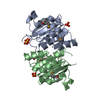
 Components
Components

 Escherichia coli (E. coli) / Strain (production host): ER2566 / References: UniProt: Q55169
Escherichia coli (E. coli) / Strain (production host): ER2566 / References: UniProt: Q55169 Sulfate
Sulfate Water
Water X-RAY DIFFRACTION / Number of used crystals: 1
X-RAY DIFFRACTION / Number of used crystals: 1  Sample preparation
Sample preparation
 Processing
Processing :
:  MAD / Resolution: 1.9→14.97 Å / Rfactor Rfree error: 0.005 / Occupancy max: 1 / Occupancy min: 1 / Isotropic thermal model: Isotropic / Cross valid method: THROUGHOUT / σ(F): 2 / σ(I): 4 / Stereochemistry target values: Engh & Huber
MAD / Resolution: 1.9→14.97 Å / Rfactor Rfree error: 0.005 / Occupancy max: 1 / Occupancy min: 1 / Isotropic thermal model: Isotropic / Cross valid method: THROUGHOUT / σ(F): 2 / σ(I): 4 / Stereochemistry target values: Engh & Huber Movie
Movie Controller
Controller



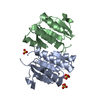

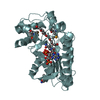
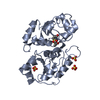
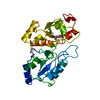

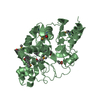

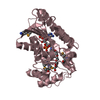

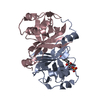
 PDBj
PDBj





